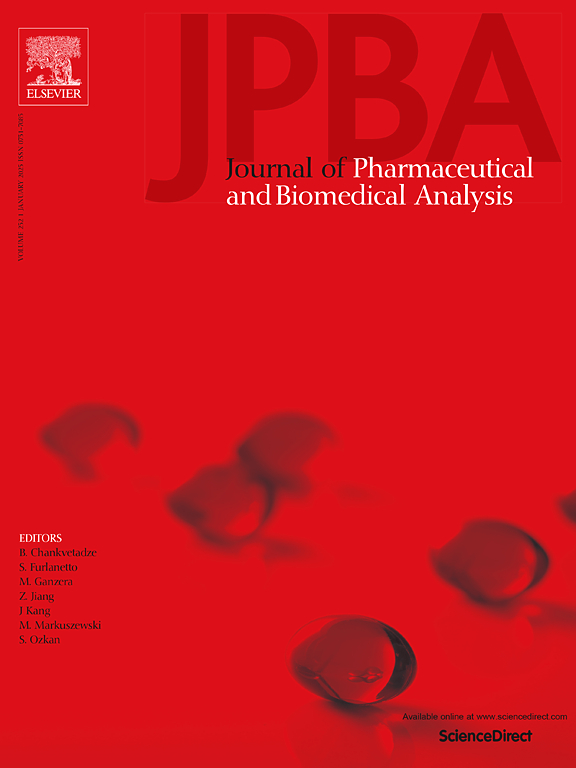Stability of the antibiotic ceftaroline fosamil with focus on degradation products and decomposition pathways – Integrative analysis by LC-DAD, ESI-QTOF and in silico prediction
IF 3.1
3区 医学
Q2 CHEMISTRY, ANALYTICAL
Journal of pharmaceutical and biomedical analysis
Pub Date : 2025-04-09
DOI:10.1016/j.jpba.2025.116876
引用次数: 0
Abstract
Stability studies are important tools for pharmacovigilance, enabling the investigation of new compounds made available to the population under different hospital conditions. Indicated for the treatment of complicated skin and soft tissue infections and community-acquired pneumonia, ceftaroline fosamil is a fifth-generation cephalosporin marketed as Zinforo®, a novel antibiotic given the long development time, in the form of powder for infusion. Due to the presence of a phosphate group, ceftaroline fosamil is a prodrug that is converted by hepatic enzymes to active form ceftaroline. The aim of the present study was to investigate the stability of ceftaroline fosamil through forced degradation studies (thermal stress) under exposures to 40°C and 60°C, and clinical use conditions under exposures to 4°C and 25°C, in the forms of powder, reconstituted in purified water, and diluted in 5 % glucose solution and 0.9 % sodium chloride solution (2.4 mg/mL, 5.0 mg/mL, and 8.4 mg/mL), for time periods of 10 min, 30 min, 60 min, 2 h, 24 h, 48 h, and 72 h. The preliminary analysis performed by HPLC-DAD showed that ceftaroline fosamil diluted at 2.4 mg/mL in a 5 % glucose solution was the least stable under clinical use conditions, with a decay of approximately 65 % of ceftaroline fosamil. Through mass spectrometry analysis by ESI-QTOF, the degradation products m/z 303, m/z 337, m/z 442, m/z 483, and m/z 543 and their degradation pathways were proposed. It was possible to partially relate the results of mass spectrometry and in silico experimental model for predicting degradation products.
抗生素头孢他林化石油的稳定性及其降解产物和分解途径——LC-DAD、ESI-QTOF综合分析和计算机预测
稳定性研究是药物警戒的重要工具,能够对在不同医院条件下提供给人群的新化合物进行调查。头孢他林(ceftaroline fosamil)是第五代头孢菌素,上市名称为zinfo®,是一种开发时间较长的新型抗生素,粉末状输注,用于治疗复杂的皮肤软组织感染和社区获得性肺炎。由于磷酸基团的存在,头孢他林是一种前药,通过肝酶转化为活性形式头孢他林。本研究的目的是调查的稳定性ceftaroline fosamil通过强制降解研究(热应力)下曝光40°C和60°C,和临床使用条件曝光4°C和25°C,在形式的粉,重组在纯净水和稀释5 %葡萄糖溶液和0.9 %氯化钠溶液(2.4 毫克/毫升,5.0 mg / mL,和8.4 毫克/毫升), 10分钟的时间,30 分钟,60 分钟,2 h, 24 h, 48 h和72 h。HPLC-DAD初步分析表明,头孢他林在5 %葡萄糖溶液中以2.4 mg/mL稀释,在临床使用条件下最不稳定,头孢他林的衰减约为65 %。通过ESI-QTOF质谱分析,确定了降解产物m/z 303、m/z 337、m/z 442、m/z 483和m/z 543的降解途径。在预测降解产物时,质谱分析结果与硅实验模型的部分关联是可能的。
本文章由计算机程序翻译,如有差异,请以英文原文为准。
求助全文
约1分钟内获得全文
求助全文
来源期刊
CiteScore
6.70
自引率
5.90%
发文量
588
审稿时长
37 days
期刊介绍:
This journal is an international medium directed towards the needs of academic, clinical, government and industrial analysis by publishing original research reports and critical reviews on pharmaceutical and biomedical analysis. It covers the interdisciplinary aspects of analysis in the pharmaceutical, biomedical and clinical sciences, including developments in analytical methodology, instrumentation, computation and interpretation. Submissions on novel applications focusing on drug purity and stability studies, pharmacokinetics, therapeutic monitoring, metabolic profiling; drug-related aspects of analytical biochemistry and forensic toxicology; quality assurance in the pharmaceutical industry are also welcome.
Studies from areas of well established and poorly selective methods, such as UV-VIS spectrophotometry (including derivative and multi-wavelength measurements), basic electroanalytical (potentiometric, polarographic and voltammetric) methods, fluorimetry, flow-injection analysis, etc. are accepted for publication in exceptional cases only, if a unique and substantial advantage over presently known systems is demonstrated. The same applies to the assay of simple drug formulations by any kind of methods and the determination of drugs in biological samples based merely on spiked samples. Drug purity/stability studies should contain information on the structure elucidation of the impurities/degradants.

 求助内容:
求助内容: 应助结果提醒方式:
应助结果提醒方式:


